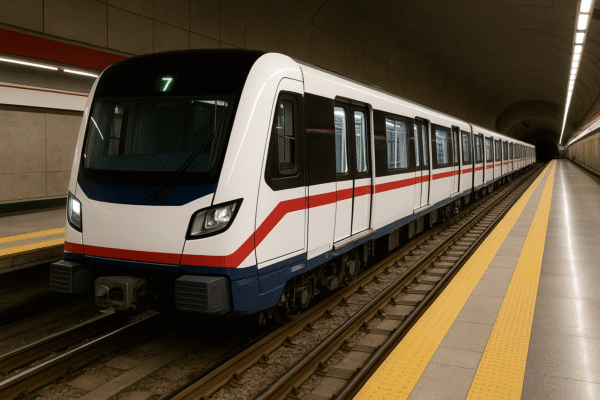🚇 Santiago Metro Line 7 Moves Closer to 2026 Launch with Sustainable Driverless Trains from Alstom
SANTIAGO, CHILE – Santiago is rapidly moving toward a greener future with the upcoming launch of Metro Line 7, a fully automated, electric metro line set to transform the city’s public transport. French rail manufacturer Alstom has completed the first carbody for the new Metropolis train fleet, marking a major step forward in the development of this advanced transit corridor expected to be operational by 2026.
This modern driverless metro line will serve over 1.4 million residents across 26 communes, from Renca and Cerro Navia in the west to Vitacura and Las Condes in the east. With chronic traffic congestion and rising air pollution in Santiago, the project is a critical investment in both mobility and environmental resilience.
🔧 Cutting-Edge Automation: Urbalis CBTC Technology
At the heart of Santiago Metro Line 7 is Alstom’s Urbalis CBTC (Communication-Based Train Control) system, a sophisticated signaling solution already used in world-class metro systems from Paris to Singapore.
This advanced system ensures real-time communication between trains and control centers, allowing for automated operation without drivers, tighter scheduling, and shorter waiting times for passengers. The CBTC technology increases train frequency and throughput, enabling more people to be moved more efficiently — a key advantage for a growing metropolis.
The CBTC system also incorporates Automatic Train Protection (ATP) to maintain safety margins at all times, preventing collisions or overspeeding. Additionally, it enables energy-efficient train operation, aligning with the global push for sustainable urban mobility.
🌱 Sustainability Goals: 100% Renewable-Powered Metro Line
Metro Line 7 is not just about efficiency—it is about environmental stewardship. As part of Santiago’s broader climate strategy, all Metropolis trains on the new line will be fully electric and powered by renewable energy.
The Chilean Ministry of Energy confirms that over 60% of the country’s electricity now comes from renewable sources, with solar and wind playing leading roles. By phasing out reliance on diesel buses and cars in favor of this clean-energy metro system, Santiago will reduce its carbon emissions and significantly improve urban air quality.
“This project is a global model of climate-conscious infrastructure,” said Nick Nuttall, a spokesman for the United Nations Environment Programme. “Chile is telling the rest of us that we need to think seriously about how we power transport.”
According to the Chilean Ministry of Transport and Telecommunications, Line 7 will reduce travel times by up to 54% for many commuters, easing daily congestion and contributing to greater equity in public access.
🔧 Predictive Maintenance: 20-Year Service Support from Alstom
Alstom’s involvement goes far beyond just delivering rolling stock. The company has also signed a 20-year maintenance contract, which includes implementation of a predictive maintenance system using real-time data analytics to monitor train and track conditions.
This proactive approach allows technicians to address potential issues before they disrupt service, ensuring maximum uptime, longer asset life, and greater safety for passengers. The system is modeled after similar successful deployments in Turin and Barcelona, and will make Santiago’s Line 7 one of the most resilient metro lines in Latin America.
📆 Construction Progress and Community Impact
The construction of Metro Line 7 began in early 2023, and is progressing steadily across multiple communes. When complete, the line will stretch approximately 26 kilometers, with new underground stations connecting underserved areas directly to Santiago’s business districts and cultural centers.
Communes that will benefit from Line 7 include Renca, Cerro Navia, Quinta Normal, Santiago Centro, Providencia, Vitacura, and Las Condes. According to Santiago Metro’s project office, over 1,200 direct jobs have already been created during the construction phase, with more anticipated during operations.
The Ministry of Public Works forecasts that the new line will increase property values in the areas it serves, spur local business development, and reduce traffic-related health impacts by reducing car dependency.
🚀 A Leap Toward a Smarter Santiago
The launch of the first Metropolis carbody is a symbolic and functional milestone in Santiago’s transportation transformation. With electric trains, real-time signaling, and sustainable power sourcing, Line 7 is set to become a global benchmark in green urban mobility.
Once operational, this high-capacity line will connect tens of thousands of commuters daily, contributing to the 2030 Sustainable Development Goals (SDGs), particularly those related to climate action, sustainable cities, and clean energy.
The Santiago Metro Line 7 initiative demonstrates how public transport can evolve into an efficient, equitable, and eco-friendly service in the 21st century. As Chile prepares for its 2026 opening, the project sends a strong signal to other cities across Latin America and beyond: modern public transport can be both high-tech and climate-resilient.
For more travel news like this, keep reading Global Travel Wire



















